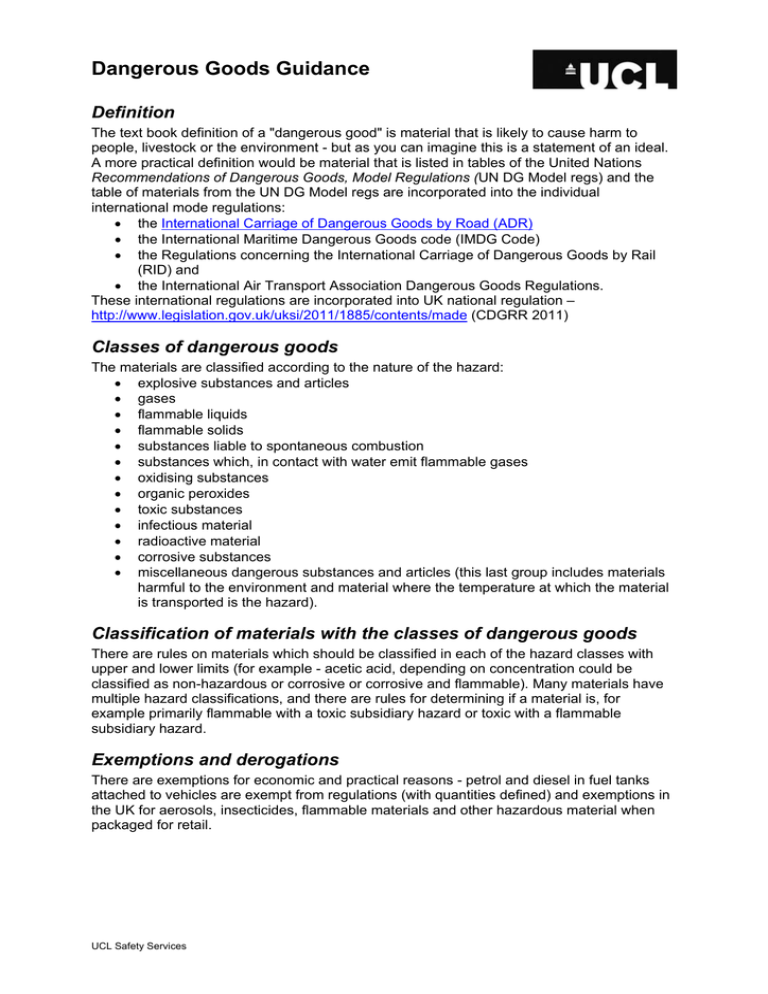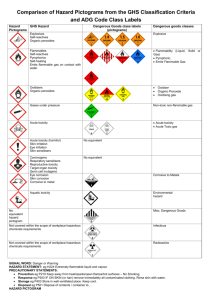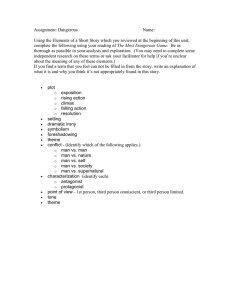Dangerous Goods Guidance Definition
advertisement

Dangerous Goods Guidance Definition The text book definition of a "dangerous good" is material that is likely to cause harm to people, livestock or the environment - but as you can imagine this is a statement of an ideal. A more practical definition would be material that is listed in tables of the United Nations Recommendations of Dangerous Goods, Model Regulations (UN DG Model regs) and the table of materials from the UN DG Model regs are incorporated into the individual international mode regulations: • the International Carriage of Dangerous Goods by Road (ADR) • the International Maritime Dangerous Goods code (IMDG Code) • the Regulations concerning the International Carriage of Dangerous Goods by Rail (RID) and • the International Air Transport Association Dangerous Goods Regulations. These international regulations are incorporated into UK national regulation – http://www.legislation.gov.uk/uksi/2011/1885/contents/made (CDGRR 2011) Classes of dangerous goods The materials are classified according to the nature of the hazard: • explosive substances and articles • gases • flammable liquids • flammable solids • substances liable to spontaneous combustion • substances which, in contact with water emit flammable gases • oxidising substances • organic peroxides • toxic substances • infectious material • radioactive material • corrosive substances • miscellaneous dangerous substances and articles (this last group includes materials harmful to the environment and material where the temperature at which the material is transported is the hazard). Classification of materials with the classes of dangerous goods There are rules on materials which should be classified in each of the hazard classes with upper and lower limits (for example - acetic acid, depending on concentration could be classified as non-hazardous or corrosive or corrosive and flammable). Many materials have multiple hazard classifications, and there are rules for determining if a material is, for example primarily flammable with a toxic subsidiary hazard or toxic with a flammable subsidiary hazard. Exemptions and derogations There are exemptions for economic and practical reasons - petrol and diesel in fuel tanks attached to vehicles are exempt from regulations (with quantities defined) and exemptions in the UK for aerosols, insecticides, flammable materials and other hazardous material when packaged for retail. UCL Safety Services Limited quantity exemptions (LQ) Some materials are exempt from the regulations in small quantities. It is necessary to check the specific model regulations to determine if LQ exemptions are possible for a particular material. Materials such as sodium metal or infectious material have no limited quantity exemption; if these are to be transported even between different UCL sites they must be packaged and carried as prescribed by the regulations. Requirements of the dangerous goods regulations Any material that is classified as a “dangerous good” must be packaged and transported as stipulated in the regulations. The regulations require that: • The material must be classified. • The material must be packaged in approved containers. • containers must be correctly marked with appropriate safety labels • staff (packers) must be competent to pack and consign the materials (this requires formal certification in some instances i.e. for material to be air freighted) • correct documentation must be dispatched with the goods • emergency information must be carried with the goods (including a 24hr emergency contact telephone number) • the couriers must be competent (i.e. drivers carrying any dangerous goods by road must have an ADR certificate) • vehicles must comply with regulations appropriate for the class of material carried Couriers Details of UCL’s approved couriers can be found at the UCL Procurement website: https://www.ucl.ac.uk/procurement/agreements/ucl-contracted-suppliers/courier Liability The consignor and couriers have duties under UK and international legislation. If you have any questions please contact Brian Kavanagh, Dangerous Goods Safety Advisor (DGSA) on UCL ext (2)8862 or e-mail b.kavanagh@ucl.ac.uk Safety Services Reference(s): Dangerous Goods First Published Reviewed UCL Safety Services September 2008 June 2014



